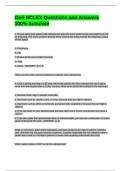Exam (elaborations)
Geri NCLEX Questions and Answers 100% Accurate
- Course
- Institution
Geri NCLEX Questions aGeri NCLEX Questions and Answers 100% AccurateGeri NCLEX Questions and Answers 100% AccurateGeri NCLEX Questions and Answers 100% AccurateGeri NCLEX Questions and Answers 100% Accuratend Answers 100% Accurate A 70 year-old female patient with osteoporosis asks the nurse which...
[Show more]



